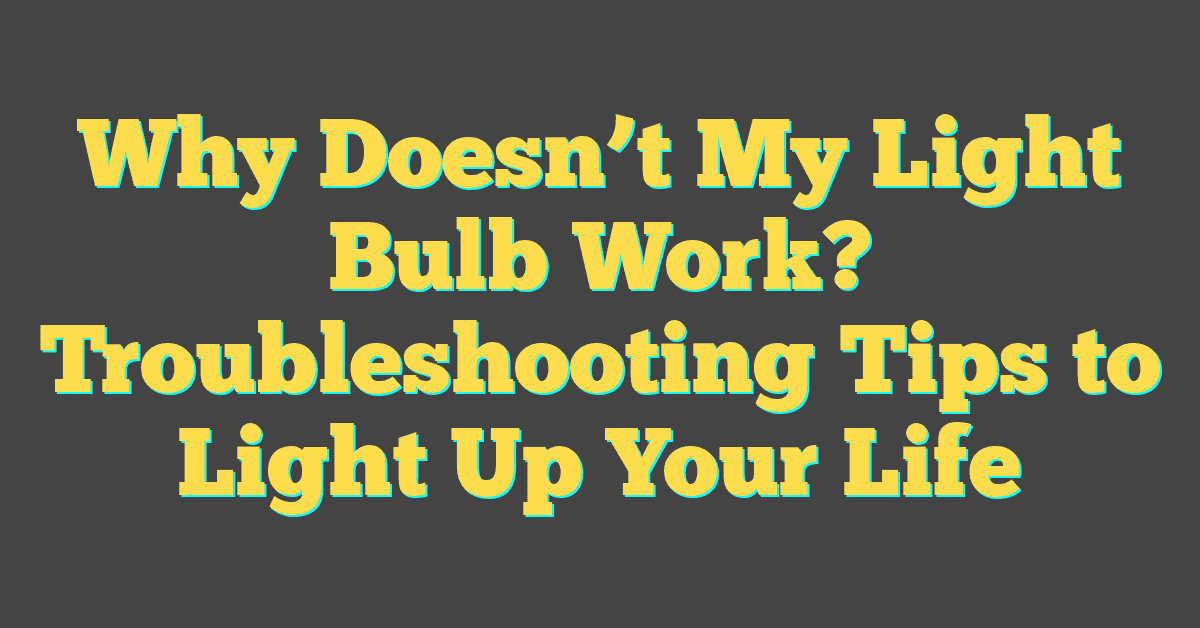Ever found yourself wrestling with a stubborn light bulb that just won’t budge? You’re not alone. Stuck bulbs are a common frustration that can turn a simple task into a test of patience.

But don’t worry, you’re about to turn the tables. With a few clever tricks up your sleeve, you’ll learn how to prevent bulbs from sticking in the first place. Say goodbye to the twist-and-shout routine and hello to smooth sailing—or should we say, unscrewing?
Why Light Bulbs Get Stuck in the First Place
As you find yourself wrestling with a stuck light bulb, you’re probably wondering how you even got into this predicament. Well, it usually comes down to a few common reasons. Understanding these could save you from future hassle.
First, over-tightening the bulb when installing it is a typical culprit. You might think, “The tighter, the better,” but that’s not the case here. When you screw a bulb in too tightly, it can cause the base to deform slightly, leading to an unyielding grip when you try to remove it.
Then there’s corrosion, an all-too-common issue. It’s chemistry in action. Metals, like the brass base of your bulb, will react with the environment over time, especially in areas with high humidity or when exposed to tiny electrical currents. This reaction can lead to a build-up that effectively cements the bulb in place.
Also, don’t overlook thermal expansion. Your light bulb heats up when it’s on and cools down when it’s off. This constant cycle of heating and cooling causes the materials to expand and contract, sometimes causing the bulb to stick to the socket.
Here’s a nifty bit of knowledge: material compatibility can also be a factor. Sometimes the materials of the bulb base and the socket don’t play well together. For instance, aluminum sockets and brass bases are a notorious combo that can lead to sticking.
Let’s run through what you need to remember:
- Avoid over-tightening bulbs.
- Be aware of environmental factors like humidity that may lead to corrosion.
- Understand the impact of thermal expansion.
- Check for compatible materials before fitting a bulb.
Forearmed with this insight, you’ll be able to take preventative steps to keep those pesky bulbs from sticking. Keep a mental checklist of these factors whenever you’re screwing in a new light bulb.
The Dangers of Forcing Stuck Light Bulbs

When you’re faced with a light bulb that just won’t seem to come loose, it might be tempting to apply a little extra elbow grease to the task. However, forcing a stuck bulb can lead to a number of risks that are worth considering before you escalate your efforts.
Firstly, excessive force can cause the bulb to break. This is more than just a mess to clean up; it can be downright dangerous. Shards of glass can scatter, causing cuts or injuries. Plus, if you’re dealing with an older bulb, there’s the added worry of potential exposure to hazardous substances like mercury, found in some fluorescent lamps.
Even if the bulb miraculously survives your rigorous attempts at removal without shattering, you’re not out of the woods yet. Manhandling a stuck bulb can damage the socket or fixture itself. The threads of the socket are designed to be engaged gently. By cranking too hard, you might strip the threads or worse, wrench the entire socket out of its mount. This repair blunder can mean lights out until you get a professional fix, and a dent in your wallet.
Furthermore, when you’re wrestling with a stubborn bulb, it’s easy to lose your footing or balance, particularly if you’re on a ladder or perched precariously trying to reach the fixture. A fall from even a modest height can lead to serious injuries.
So before you Hulk out on that unyielding light bulb, it’s worth considering a more measured approach. Remember, light bulbs and fixtures aren’t built for brawn—they require a gentle, strategic touch. Armed with the right techniques and tools, you can remove even the most stubborn bulb safely and efficiently, all without risking personal injury or property damage. Keep these points in mind the next time you’re faced with the challenge, and handle with care to light up your space stress-free.
Precautions to Take Before Attempting to Remove a Stuck Light Bulb
« What Light Bulbs Have a Yellow Tint? Unlock Warmth in Your Home
What Is the Problem with Light Bulbs? Unveiling the Shocking Truth »

Before you dive into the task of freeing a jammed light bulb, it’s crucial to ensure your own safety and the well-being of your lighting fixture. Taking the right precautions can save you from potential hazards and avoid unnecessary damage.
Switch Off the Power
First things first, turn off the power at the switch. It’s a simple step, but it’s vital for preventing any chance of electrical shock when handling the fixture. If you want to be extra cautious, go ahead and turn off the power at the circuit breaker too.
Allow the Bulb to Cool
If the bulb was on recently, give it some time to cool down. Even the most experienced DIY enthusiasts know it’s easy to forget that bulbs can get extremely hot, and touching a heated bulb can result in a nasty burn.
Safety Gear
You might not think you need them, but don safety goggles and gloves anyway. Tiny glass fragments and the possibility of a bulb breaking apart unexpectedly can pose a real threat to your eyes and hands.
- Goggles will protect your eyes from any glass shards.
- Gloves provide a better grip on the bulb and safeguard your hands from cuts and from any potentially harmful substances inside the bulb.
Ensure Stable Footing
Before attempting to twist out the stubborn bulb, make sure you’re standing on a stable surface. If you’re reaching above, using a step ladder with firm footing is better than an unstable chair. After all, maintaining your balance is key to avoiding falls and injuries.
Use the Correct Approach
Finally, understand the bulb’s type and the correct method to remove it. Not all light bulbs are created equal, and some, like fluorescent tubes or halogen bulbs, require specific handling. Review the bulb manufacturer’s guidelines if necessary and prepare the right tools for the job—sometimes, a piece of rubber or a suction cup can offer just the right amount of grip without the added force.
Methods to Use for Loosening a Stuck Light Bulb

When you’re faced with the challenge of a stuck light bulb, there’s no need to call it quits. Various methods can help you dislodge that stubborn light without causing damage to your fixture or the bulb itself. Let’s shed some light on these tricks so you can get back to illuminating your space in no time.
Firstly, patience is key. As tempting as it may be to force the bulb out, a gentle approach is more effective. One method involves using a dry rubber grip pad. The kind you might use to open a tight jar lid. Place the pad around the bulb’s base and gently twist counterclockwise. The additional grip can make all the difference without applying excessive force that could break the bulb.
For those pesky bulbs that just won’t budge, you might need to employ the duct tape method. Take a generous length of duct tape and press the center part onto the bulb. Fold each end back onto itself to create two extended wings. Hold these wings to turn the bulb. It might give you the leverage you need without any slippage.
If you’re dealing with a bulb in a recessed fixture, suction cups can be your best friend. Firmly press a suction cup onto the bulb and use it as a handle to twist the bulb loose. This is especially useful for those hard-to-reach spots and minimizes the risk of dropping the bulb.
Should the bulb’s base break off, leaving you with the threaded part still in the socket, don’t fret just yet. Power off the fixture and use needle-nose pliers to grip the edges of the base and slowly rotate it out. Only attempt this with the right protective gear as the risk of the bulb breaking is higher. It might also be wise to have a backup plan in case the bulb shatters despite your careful efforts.
Remember, the key to preventing a stuck bulb is regular maintenance. Ensure you’re not over-tightening the bulbs when installing them, and occasionally give them a gentle twist to keep them from becoming immobile. With these methods in your arsenal, you’ll keep the light shining bright and maintenance a breeze.
Tips to Prevent Light Bulbs from Getting Stuck in the Future

When dealing with light bulbs, prevention is key. Adopting certain habits and techniques will save you from the frustration of a bulb that won’t budge down the line. Here’s what you can do:
Grease the Threads
Before you even think about screwing in that new bulb, consider dabbing a tiny bit of dielectric grease on the threads. This non-conductive lubricant helps prevent corrosion, which is a prime suspect in the case of stuck bulbs.
- Apply lightly — a thin layer will do.
- Do not use conductive lubricants as they can cause electrical shorts.
Choose the Right Bulbs
Quality also plays a role in prevention. High-quality bulbs are less likely to degrade over time. When shopping for bulbs:
- Look for reputable brands.
- Avoid bargain bins — these bulbs are often more prone to issues.
Regular Maintenance
Just like you, your light fixtures need regular check-ups.
- Tighten them periodically but not too much: over-tightening can damage the bulb’s base.
- Clean the socket with a dry cloth to remove dust and prevent debris accumulation.
Be Mindful of Environment
The location of your light fixtures can impact how often bulbs get stuck.
- In high humidity areas, consider moisture-resistant fixtures.
- Avoid installing lights where they’ll be exposed to temperature extremes.
By following these preventative measures, you ensure that every light bulb change is a smooth process. Always take caution when handling electrical components and make sure the power is off before you start. With a bit of attention and care, you can significantly reduce the chances of ever having to wrestle with a stubborn light bulb again. So go ahead, light up your world with confidence and remember, a little foresight goes a long way in your home DIY lighting projects.
Conclusion
Now that you’ve got the know-how to tackle those pesky stuck light bulbs safely, you can say goodbye to the frustration they bring. Remember, a bit of prevention goes a long way. So, don’t wait until you’re under the gun—take a moment to maintain your light fixtures and apply these simple tips. With a little care and the right techniques, you’ll keep the lights on and the stress off. Here’s to bright ideas and even brighter days ahead!
Frequently Asked Questions
How can I remove a stuck light bulb without damaging it?
To remove a stuck light bulb without causing damage, try using a dry rubber grip pad to enhance your grip. If the bulb is still immovable, you can also apply the duct tape method, which involves molding duct tape over the bulb and twisting.
What should I do if the light bulb’s base breaks off?
If the base of the light bulb breaks off, use needle-nose pliers to grasp the edge of the base and gently twist it out of the socket. Ensure the power is turned off before attempting this.
Can I prevent light bulbs from getting stuck?
Yes, you can prevent light bulbs from getting stuck by greasing the threads with a suitable lubricant, using high-quality bulbs, performing regular maintenance, and being attentive to the environmental conditions where the bulbs are used.
Is there a method to remove recessed light bulbs that are stuck?
For recessed light bulbs that are stuck, employing a suction cup can be effective. Press a suction cup onto the face of the bulb and twist to loosen and remove it.
Why is regular maintenance important for preventing stuck light bulbs?
Regular maintenance is important because it reduces the chances of corrosion or debris buildup, which can cause a light bulb to become stuck in its fixture over time. Regularly checking and cleaning the sockets can help prevent this issue.




